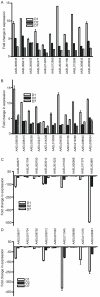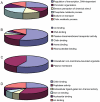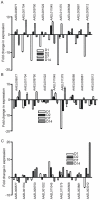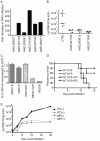Alterations in the Aedes aegypti transcriptome during infection with West Nile, dengue and yellow fever viruses
- PMID: 21909258
- PMCID: PMC3164632
- DOI: 10.1371/journal.ppat.1002189
Alterations in the Aedes aegypti transcriptome during infection with West Nile, dengue and yellow fever viruses
Abstract
West Nile (WNV), dengue (DENV) and yellow fever (YFV) viruses are (re)emerging, mosquito-borne flaviviruses that cause human disease and mortality worldwide. Alterations in mosquito gene expression common and unique to individual flaviviral infections are poorly understood. Here, we present a microarray analysis of the Aedes aegypti transcriptome over time during infection with DENV, WNV or YFV. We identified 203 mosquito genes that were ≥ 5-fold differentially up-regulated (DUR) and 202 genes that were ≥ 10-fold differentially down-regulated (DDR) during infection with one of the three flaviviruses. Comparative analysis revealed that the expression profile of 20 DUR genes and 15 DDR genes was quite similar between the three flaviviruses on D1 of infection, indicating a potentially conserved transcriptomic signature of flaviviral infection. Bioinformatics analysis revealed changes in expression of genes from diverse cellular processes, including ion binding, transport, metabolic processes and peptidase activity. We also demonstrate that virally-regulated gene expression is tissue-specific. The overexpression of several virally down-regulated genes decreased WNV infection in mosquito cells and Aedes aegypti mosquitoes. Among these, a pupal cuticle protein was shown to bind WNV envelope protein, leading to inhibition of infection in vitro and the prevention of lethal WNV encephalitis in mice. This work provides an extensive list of targets for controlling flaviviral infection in mosquitoes that may also be used to develop broad preventative and therapeutic measures for multiple flaviviruses.
Conflict of interest statement
The authors have declared that no competing interests exist.
Figures







References
-
- Mackenzie JS, Gubler DJ, Petersen LR. Emerging flaviviruses: the spread and resurgence of Japanese encephalitis, West Nile and dengue viruses. Nat Med. 2004;10:S98–109. - PubMed
-
- Gubler DJ. Epidemic dengue/dengue hemorrhagic fever as a public health, social and economic problem in the 21st century. Trends Microbiol. 2002;10:100–103. - PubMed
-
- site PAHOw. 2007. Number of reported cases of dengue and dengue hemorrhagic fever (DHF) in the Americas, by country: figures for 2007.
Publication types
MeSH terms
Substances
Grants and funding
LinkOut - more resources
Full Text Sources
Other Literature Sources
Molecular Biology Databases

